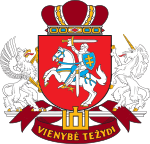Coat of arms of Lithuania
| Coat of arms of Lithuania Lietuvos herbas Vytis |
|
|---|---|
 |
|
| Versions | |

Presidential version
|
|

Parliamentary version
|
|
| Details | |
| Armiger | Republic of Lithuania |
| Adopted | First documented in 1366. Current version official since 1991. |
| Escutcheon | Gules, an armoured knight armed cap-à-pie mounted on a horse salient holding in his dexter hand a sword Argent above his head. A shield Azure hangs on the sinister shoulder charged with a double cross (Cross of Lorraine) Or. The horse saddles, straps, and belts Azure. The hilt of the sword and the fastening of the sheath, the stirrups, the curb bits of the bridle, the horseshoes, as well as the decoration of the harness, all Or. |
| Earlier versions | see below |
The coat of arms of Lithuania, consisting of an armour-clad knight on horseback holding a sword and shield, is also known as Vytis (pronounced: [ʋiːt̪ɪs] (coined). It is one of very few containing symbolism adopted from ducal portrait seals rather than from coats of arms of dynasties, which is the case for most European countries.
Article 15 of the Constitution of Lithuania, approved by national referendum in 1992, stipulates, "The Coat of Arms of the State shall be a white Vytis on a red field". Heraldic shield features the field Gules (red) with an armoured knight on a horse salient Argent (white). The knight is holding in his dexter hand a sword Argent above his head. A shield Azure hangs on the sinister shoulder of the knight with a double cross Or (yellow) on it. The horse saddle, straps, and belts are Azure. The hilt of the sword and the fastening of the sheath, the stirrups, the curb bits of the bridle, the horseshoes, as well as the decoration of the harness, are Or (gold).
The blazon is the following:
Gules, a knight armed cap-à-pie mounted on a horse salient argent, brandishing a sword proper and maintaining a shield azure charged with a cross of Lorraine Or.
The knight on horseback without a specific name was mentioned in the Tobolsk Chronicle as a symbol of Narimantas. The charging knight is depicted on the seal of Grand Duke of Lithuania, Algirdas, dated 1366. The earliest coins featuring the knight come also from the last quarter of the 14th century; the other side of these coins depicts Columns of Gediminas. The emblem was handed down through the generations, from Algirdas to his son, Grand Duke Jogaila, then to Jogaila's cousin Grand Duke Vytautas and others. In the 14th century, the knight was featured on a heraldic shield, first on Jogaila's seal in 1386 or 1387, and also on the seal of Vytautas in 1401. At the Battle of Grunwald in 1410, the major victory of the united Polish–Lithuanian army against the Teutonic Order, thirty Lithuanian regiments out of the total forty were flying the "charging knight" banner.
...
Wikipedia
